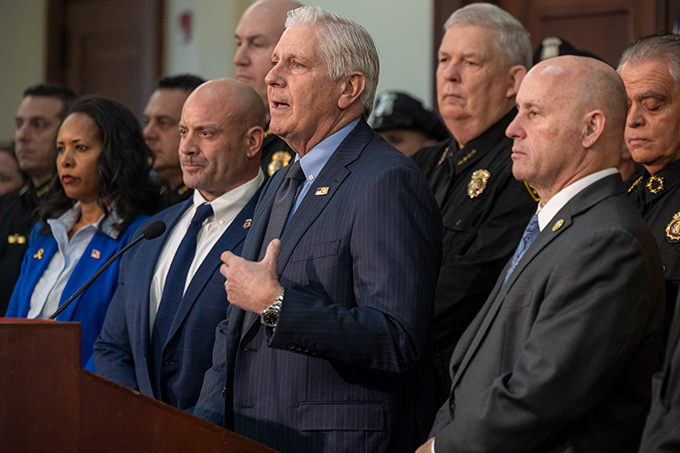New Yorkers are increasingly frustrated with crime caused by illegal immigration. High-profile incidents have stoked the outrage, including December’s horrific subway immolation of Debrina Kawam by an intoxicated illegal immigrant, and the controversial bail-free release of two Venezuelan gang members. A recent Siena poll shows overwhelming support among New Yorkers for deporting illegal immigrants convicted of crimes; a plurality also favors greater local cooperation with federal immigration enforcement.
Yet, of New York State’s 62 counties, only three—Nassau, Rensselaer, and Broome—have formal cooperation agreements with U.S. Immigration and Customs Enforcement (ICE) under its flagship 287(g) program. Authorized by a 1996 amendment to the Immigration and Naturalization Act, 287(g) allows ICE to deputize local law enforcement officers to identify illegal aliens in custody and perform other immigration functions. To protect the public, every New York county should be participating in the program, at least to some degree.
Finally, a reason to check your email.
Sign up for our free newsletter today.
Of course, each county’s level of engagement can—and should—be calibrated to its own resources, priorities, and public-safety needs. For instance, smaller or more rural counties such as Rensselaer with relatively few immigration-related arrests may choose basic jail‐screening agreements that empower ICE agents to interview and detain eligible individuals without deputizing local officers for immigration investigations. Larger jurisdictions facing higher caseloads can pursue the more hands-on 287(g) task force model.
Nassau County on Long Island offers the most comprehensive example of participation in the program. Of the three New York counties, it has taken federal cooperation the furthest, moving beyond standard jail agreements to join the 287(g) task force model, recently brought back by the Trump administration after a decade-long hiatus. Under this arrangement, County Executive Bruce Blakeman has assigned ten police detectives to train directly with ICE, granting them limited immigration enforcement powers that they can use during routine police work.
Blakeman has justified this enhanced enforcement by highlighting serious local crimes committed by illegal immigrants, including a string of burglaries by South American gang members who cut off their ankle monitors and the rape of a five-year-old Westbury girl by a Honduran national illegally present in the United States. Long Island has struggled for years with transnational gangs, notably MS-13, whose ranks often include criminal migrants.

What’s holding back the rest of New York? Not just inaction, but also obstruction from many local officials. Cities such as Sleepy Hollow, Peekskill, and Rochester have publicly declared that they will refuse ICE cooperation unless compelled by judicial warrants. Rochester’s Mayor Malik Evans and Police Chief David Smith recently condemned their own officers for assisting Homeland Security Investigations agents during a contentious traffic stop, underscoring the depth of ideological resistance in some localities.
Some county sheriffs have taken this obstruction even further. Tompkins County Sheriff Derek Osborne is currently under federal investigation after ignoring an ICE detainer request and releasing a criminal alien following his guilty plea and sentencing for an assault charge. (Osborne insists that his defiance aligns with local policy.) Onondaga County Sheriff Toby Shelley similarly refuses to detain criminal aliens without judicial warrants, framing cooperation with ICE as incompatible with constitutional rights.
That claim is wildly at odds with the reality of the 287(g) program, which includes clear guidelines and oversight. Local law enforcement officers must complete ICE-administered training that emphasizes the protection of civil rights. The program also provides rigorous training and technical support, and its flexible framework lets counties calibrate cooperation to local needs, as the different approaches taken by Nassau and Rensselaer demonstrate.
With three counties already demonstrating the effectiveness of targeted 287(g) partnerships, the framework for broader enforcement is in place across New York State. Mayor Eric Adams—now running as an independent in the 2025 mayoral race—pledged to reopen an ICE office on Rikers Island after meeting with border czar Tom Homan; he appears to be following through. No longer bound by Democratic Party orthodoxy, Adams has an opportunity to prioritize public safety over political expediency. In a hotly contested mayoral race, Adams may be able to differentiate himself by pursuing a rational and popular policy of immigration enforcement.
The infrastructure and public support already exist to remove criminal aliens from New York’s communities. Refusing to deport them is an abdication of the responsibility to protect law-abiding citizens and uphold the rule of law.
Top Photo: U.S. Customs and Border Protection security agents guide illegal immigrants onto a removal flight at Fort Bliss, Texas, in January. (Dept. of Defense photo by U.S. Army Sgt. 1st Class Nicholas J. De La Pena via Getty Images News)
City Journal is a publication of the Manhattan Institute for Policy Research (MI), a leading free-market think tank. Are you interested in supporting the magazine? As a 501(c)(3) nonprofit, donations in support of MI and City Journal are fully tax-deductible as provided by law (EIN #13-2912529).
Source link

















